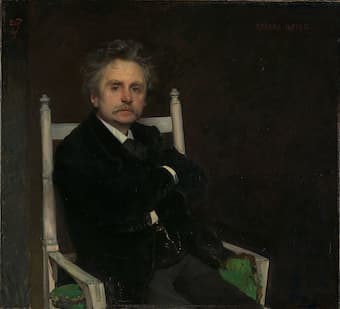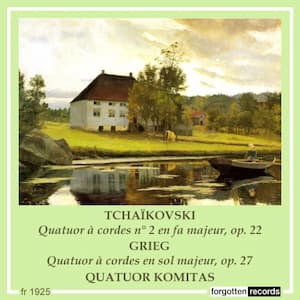
Eilif Peterssen: Portrait of the Composer Edvard Grieg (1891) (Oslo: Nasjonalmuseet)
We credit Haydn for codifying it, Mozart for extending it, and Beethoven for bringing it to its highest level. We look to Norwegian composer Edvard Grieg (1843-1907), however, to take Beethoven’s ideas and move them forward yet again.
We generally consider Grieg in his nationalistic garb, as the composer of Peer Gynt and folkloric works such as Wedding Day at Troldhaugen. However, his sole string quartet, completed in 1877 and given its premiere in Cologne in 1878, pushed Beethoven’s op. 133 boundaries further again.

Past line-ups of the Komitas Quartet
© www.komitas.am
Through the work, Grieg uses double stop techniques and more-than-four-part chords (the first movement opens with a 12-part chord), techniques more familiar from orchestral music than string quartet writing. His bold harmonies, the drama and intensity in his writing, and the orchestral effects were more than even Brahms would go in his quartet writing.
In writing to friend about the work, Grieg said ‘it strives towards breadth, soaring flight and above all resonance for the instruments for which it is written.’ Integral to the work, but invisible to the listener, is a poem by Ibsen that reflects ‘the thoughts of a musician separated from his beloved, meditating, as he walks on a summer evening by a stream, on the possibility of some water spirit bringing his beloved to him again.’ Set as a song by Grieg, the melody operates as a unifying melody across the whole of the quartet. The final of the quartet uses a saltarello rhythm as its driving force after a slow introduction.
Grieg’s usual publisher, C.F. Peters rejected the work because of the double stopping caused them to fear that the work would have to be rewritten adding a piano (as a piano quartet or quintet), so Grieg found another publisher and it was only after the success of that first edition that Peters decided to publish it as well.
Although Grieg attempted three quartets, this is the only complete one. The first was lost, this is the second, and a third one is incomplete.
Edvard Grieg: String Quartet in G major, Op. 27 – IV. Finale: Lento – Presto e saltarello
This recording, made in 1952, was performed by the Komitas Quartet, members Avet Gabrielyan (1st violin), Rafael Davidyan (2nd violin), Henrik Talalyan (viola), and Sergey Aslamazyan (cello). The first violinist and the cellist were two of the founding members of the group in November 1924. The Quartet was founded in Moscow and is the oldest-established string quartet in the world that is still performing and is now in its 96th year. It is also the best-known musical group from Armenia.

Performed by
Komitas Quartet
Recorded in 1952
Official Website
For more of the best in classical music, sign up to our E-Newsletter

This quartet is no longer played regularly by quartets, and it is inexplicable as to the reason. It is full of life, well-written for the quartet (difficult, but not inordinately so—plenty of Beethoven quartets are much more difficult…), makes the group sound good (when played well, of course…), and the audience generally loves it. This piece deserves to be widely known, enjoyed and loved. It is amazing to think that as high and voluminous the quartet repertoire is there are still so many quartets that are wonderful, and yet so neglected. I see that the Tchaikovsky 2nd quartet is in the recording above, and it reminds me that the THIRD quartet of Tchaikovsky, in the very unusual key of e-flat MINOR, is also a really wonderful work.